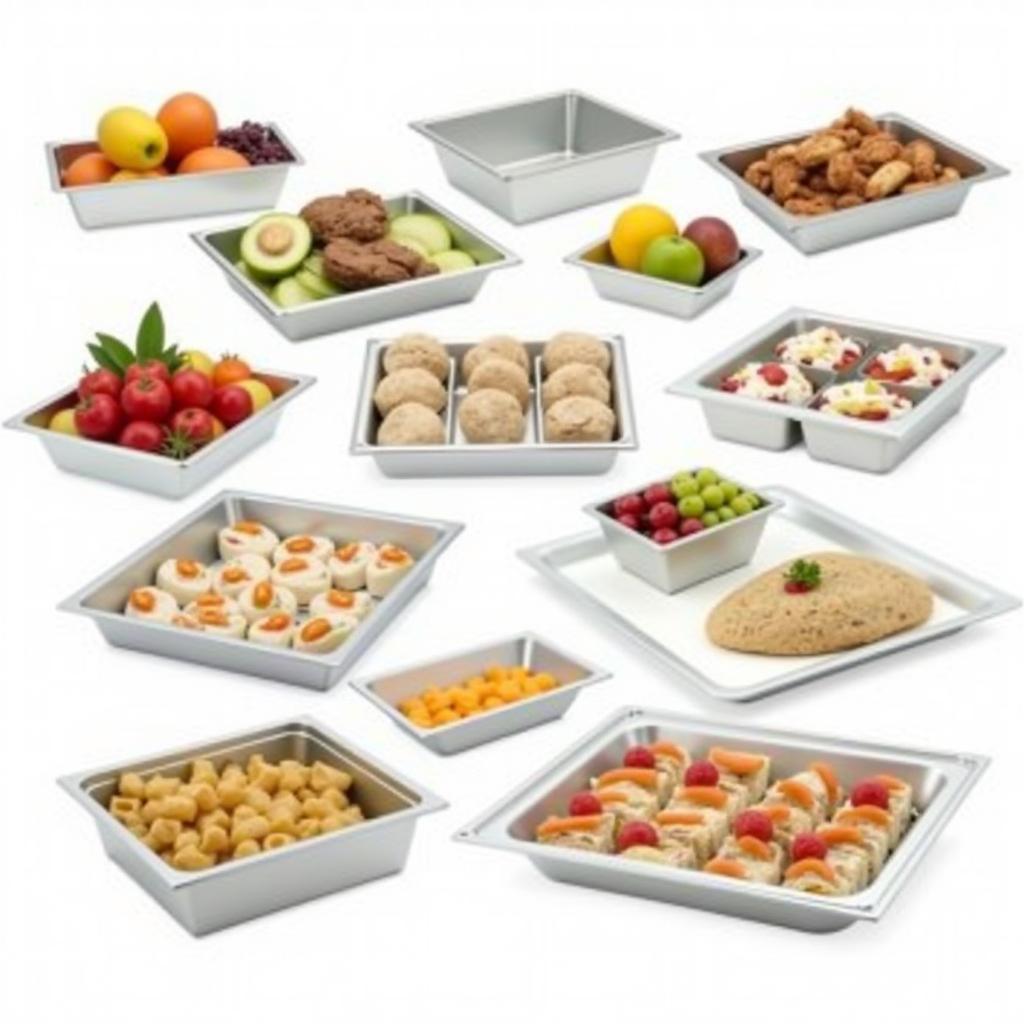Cooler Food Trays are an essential tool for anyone who wants to keep their food fresh and delicious, whether you’re hosting a party, going on a picnic, or simply packing a lunch for work. These versatile trays come in a variety of sizes and materials, making it easy to find the perfect one for your needs. But with so many options available, it can be tough to know where to start. This comprehensive guide will cover everything you need to know about cooler food trays, from choosing the right one to using it effectively to maximize freshness and flavor.
 Cooler Food Trays in Variety of Sizes and Materials
Cooler Food Trays in Variety of Sizes and Materials
Why Use a Cooler Food Tray?
You might be wondering, why not just throw everything directly into the cooler? While convenient, this method can lead to soggy sandwiches, crushed snacks, and a messy cooler situation. This is where cooler food trays come in handy. They offer a range of benefits:
- Organization: Separate your drinks from your snacks, your fruits from your veggies, keeping your cooler neat and organized.
- Protection: Safeguard delicate foods from getting squashed by heavier items.
- Even Cooling: Elevate your food from the bottom of the cooler, allowing for better cold air circulation and more even cooling.
- Easy Access: Quickly find what you’re looking for without having to dig through a jumbled mess.
Types of Cooler Food Trays
Finding the perfect cooler food tray depends on your specific needs and preferences. Here are some key factors to consider:
1. Size and Capacity
Cooler food trays come in a variety of sizes, so it’s important to choose one that will fit comfortably in your cooler and accommodate the amount of food you plan to pack. Food tray size can vary significantly, so make sure to measure your cooler’s interior dimensions before making a purchase.
2. Material
The material of your cooler food tray can affect its durability, ease of cleaning, and even how well it insulates your food.
- Plastic: Lightweight, affordable, and often dishwasher safe. However, they may not be as durable as other materials.
- Melamine: Durable, scratch-resistant, and often available in a variety of colors and designs.
- Stainless Steel: Durable, rust-resistant, and easy to clean. They can be more expensive than other options.
3. Features
Some cooler food trays come with additional features that can enhance their functionality.
- Lids: Keep your food securely contained and prevent spills.
- Handles: Make it easy to transport the tray to and from your cooler.
- Dividers: Create separate compartments within the tray to further organize your food.
Tips for Using Your Cooler Food Tray
Getting the most out of your cooler food tray goes beyond just choosing the right one. Here are some expert tips to keep in mind:
- Pre-Chill Your Tray: For optimal coolness, pre-chill your tray in the refrigerator for a few hours before packing it with food.
- Pack Strategically: Place items that need to stay coldest at the bottom of the tray and less temperature-sensitive items on top.
- Utilize Ice Packs: Don’t rely solely on your cooler’s ice. Distribute ice packs or frozen water bottles around the tray to maintain a consistent temperature.
- Avoid Overpacking: Leave some space between items for proper air circulation.
- Clean Thoroughly: After each use, wash your cooler food tray with warm soapy water to prevent bacterial growth and maintain hygiene.
Cooler Food Tray Ideas for Every Occasion
A cooler food tray is a versatile tool for various occasions. Here are a few ideas:
- Picnics: Keep your sandwiches, salads, and cooling tray food organized and fresh.
- Camping Trips: Protect your ingredients and snacks from getting crushed in your camping cooler.
- Tailgating Parties: Transport your dips, chips, and other party snacks with ease.
- Lunchboxes: Pack a neater, more organized lunch for work or school.
“Cooler food trays are a game-changer for food storage and transport,” says renowned chef, Emily Carter. “They not only keep my ingredients organized and protected but also help maintain optimal freshness, crucial for preserving flavors and textures, especially during outdoor events.”
Conclusion
Investing in a quality cooler food tray can significantly elevate your food storage and transportation experience. By understanding the different types, features, and usage tips, you can make informed choices to keep your food fresh, organized, and delicious wherever you go. So, whether you’re planning a picnic, a camping trip, or simply packing a lunch, a cooler food tray is an essential tool to have on hand.
FAQs
1. Can I use a cooler food tray in the freezer?
While some cooler food trays are freezer-safe, it’s essential to check the manufacturer’s instructions.
2. What is the best way to clean a cooler food tray?
Most cooler food trays can be washed with warm, soapy water. For stubborn stains, you can use a baking soda paste.
3. Are cooler food trays microwavable?
Generally, it’s not recommended to microwave cooler food trays unless they are specifically labeled as microwave-safe.
4. Can I use a cooler food tray for hot food?
It’s best to use cooler food trays for cold or room-temperature foods. High temperatures can damage some materials.
5. Are there eco-friendly cooler food tray options available?
Yes, many brands now offer cooler food trays made from recycled or sustainable materials. Look for options labeled as BPA-free and eco-friendly.
Need more tips for your next food venture? Check out our articles on food coloring for drinks and delicious food to sell at garage sale.
Have other questions or need assistance? Contact us at Phone Number: 02437655121, Email: [email protected] Or visit us at: 3PGH+8R9, ĐT70A, thôn Trung, Bắc Từ Liêm, Hà Nội, Việt Nam. Our customer service team is available 24/7 to assist you.